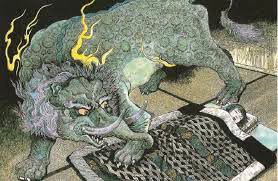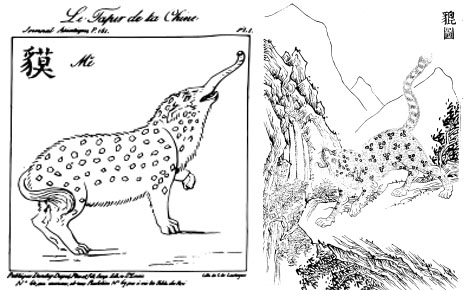 |
(1)
황교안이 푹 주무셨다. 그것도 국제행사장에서 숙면을 취하셨다. 어떤 신문은 졸았다고 하는데 사진 보니 그냥 작정하고 퍼질러 주무신 모양이다.
웃기는 건 바로 그날 아침 황교안이 당원들에게 “졸면 안돼!” 라고 말씀하셨다는 것이다. “요즘 우리 당에 대해 여러가지 이야기가 나옵니다만..... 지금 조는 분이 계시네요. 곤란한 일입니다."
 |
(2)
사실 황교안은 잠이 절대적으로 부족했다. 황교안 말마따나 요즘 자유한국당에 대해 여러가지 이야기가 나오고 있기 때문이다. 특히 황교안에 대해 여러가지 이야기가 나오고 있는 상황 아닌가. 제 정신으로 어찌 주무신단 말인가.
그리하여 황교안은 까만 밤을 지새우며 전전반측이었던 것이다. 잠을 못이뤘던 것이다. 수면부족이었던 것이다.
입만 열면 욕만 바가지로 얻어 먹는다. 당내에서도 리더십 없다고 왈왈댄다. 뭐 오만가지 이유가 있지만 생략하자. 그래서 황교안은 밤마다 악몽을 꾸고 숙면을 못 취한다는 것이다.
 |
(3)
“황교안은 우리 편”이라고 합리적 오해를 한 어떤 일본 귀신이 전전반측 황교안을 불쌍히 여겼다. 그 귀신은 황교안의 악몽을 냠냠 먹어 편히 잠잘 수 있게 해주었다.
덕분에 황교안이 한숨 푹 잘 수 있었다는 것이다. 근데 그 귀신은 하필이면 그날 거기서 주무시도록 했나 모르겠네. 그 귀신도 빠가야로.
 |
(부록)
바쿠
Baku, 獏 or 貘. 잠자는 사람의 악몽을 먹어, 숙면을 도와준다. devour nightmares. 일명 ‘nightmare-devouring baku’. Japanese supernatural beings.
전설
Legend has it, that a person who wakes up from a bad dream can call out to baku. A child having a nightmare in Japan will wake up and repeat three times, "Baku-san, come eat my dream." Legends say that the baku will come into the child's room and devour the bad dream, allowing the child to go back to sleep peacefully. However, calling to the baku must be done sparingly, because if he remains hungry after eating one's nightmare, he may also devour their hopes and desires as well, leaving them to live an empty life. The baku can also be summoned for protection from bad dreams prior to falling asleep at night. In the 1910s, it was common for Japanese children to keep a baku talisman at their bedside.
원산지는 중국
중국에서 훔쳐온 캐릭터. 기원은 중국이지만 악몽을 잡숫는 능력은 일본 바쿠의 특징. originates in Chinese folklore about the mo(貘). was familiar in Japan as early as the Muromachi period (14th-15th century).
출생의 비밀
According to legend, they were created by the spare pieces that were left over when the gods finished creating all other animals.
생김새
그림 보셔. An early 17th-century Japanese manuscript, the Sankai Ibutsu (山海異物), describes the baku as a shy, Chinese mythical chimera with an elephant’s trunk, rhinoceros' eyes, an ox's tail, and a tiger's paws, which protected against pestilence and evil, although eating nightmares was not included among its abilities. in a 1791 Japanese wood-block illustration, a specifically dream-destroying baku is depicted with an elephant’s head, tusks, and trunk, with horns and tiger’s claws. The elephant’s head, trunk, and tusks are characteristic of baku portrayed in classical era (pre-Meiji) Japanese wood-block prints (see illustration) and in shrine, temple, and netsuke carvings.
 |
(관련기사)
당원들에게 "졸지말라"고 지적했던 황교안 자유한국당 대표. 정작 본인은 국제행사에 참석해 꾸벅꾸벅.... (채널A)
국제행사 자리서 50분간 꾸벅꾸벅 졸다가 딱 걸린 황교안 자유한국당 대표... (인사이트)
황교안 자유한국당 대표가 2019년 광주세계수영선수권대회 개막행사 도중 조는 모습이 포착돼 빈축을 사고 있다. 옆자리에 앉아 있던 손학규 바른미래당 대표도 똑같이 눈을 감고 있었지만 황 대표에게 유난이 관심.... (국민일보)
첫 번째 키워드 보시죠 “조는 분 계시나요” 황교안 자유한국당 대표의 모습이군요 네 황교안 자유한국당 대표와 손학규 바른미래당 대표가 어제 열린 '2019 광주 세계 수영 선수권 대회' 개막행사 도중 잠을 자는 듯한... (TV조선)
 |
| “교안이..... 오늘밤 방문 열어 두시게.....” |
관리자 freemediaf@gmail.com
<저작권자 © 자유언론실천재단, 무단 전재 및 재배포 금지>

